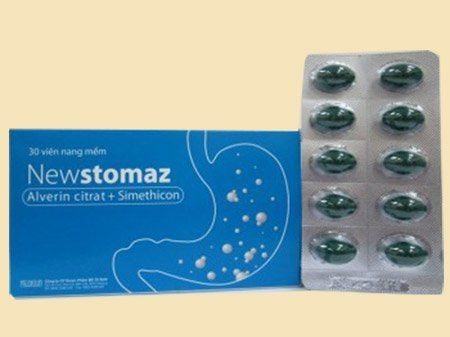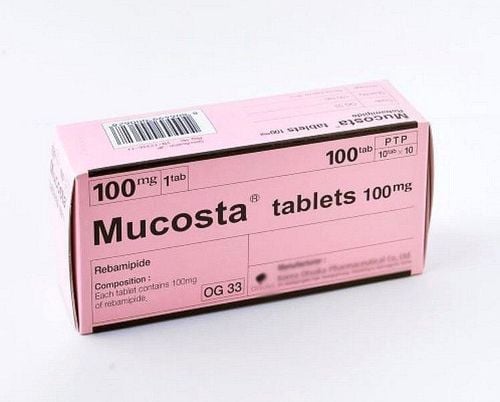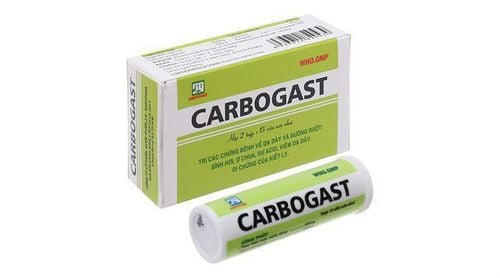This is an automatically translated article.
Naptogast 20 is often prescribed by doctors for cases of gastroesophageal reflux disease - esophagitis, peptic ulcer, ... To use Naptogast 20 to achieve optimal effectiveness, patients need to use Naptogast 20. Take the medicine at the right dose and for the right time.
1. What is Naptogast 20?
Naptogast 20 belongs to the group of gastrointestinal drugs, used mainly to treat gastroesophageal reflux disease, gastrointestinal ulcers or peptic ulcers.
Currently, Naptogast 20 is made in the form of hard capsules and packaged in a box of 2 blisters x 6 tablets or a box of 2 blisters x 7 tablets. Each Naptogast 20 capsule contains the main active ingredient, Pantoprazol (in the form of enteric-coated microparticles 8.5%) with a concentration of 20mg and a number of other excipients just enough.
2. Indications and contraindications for the use of Naptogast 20
2.1 Indications for use of Naptogast 20 Naptogast 20 is usually prescribed by doctors for the following cases:
Treatment for patients with gastroesophageal reflux syndrome (GERD). Treatment of peptic ulcer or peptic ulcer. Treatment of pathological hyperacidity, such as Zollinger-Ellison syndrome. Support the prevention of gastric and duodenal ulcers caused by the use of non-steroidal anti-inflammatory drugs. 2.2 Contraindications to the use of Naptogast 20 Naptogast 20 should not be used in the following cases:
Patients with allergies or hypersensitivity to Pantoprazol, other Benzimidazole derivatives (eg Lansoprazol, Esomeprazole, Rabeprazole, Omeprazol) or any other excipients in the drug. Naptogast 20 is contraindicated in pregnant and lactating women.
3. Dosage and how to use Naptogast 20
3.1 Dosage of Naptogast 20 as recommended The dosage of Naptogast 20 will be determined based on the patient's health condition, specifically:
Dosage for treatment of gastroesophageal reflux disease (GERD) GERD):
Usual dose: Take from 20-40mg / time / day, use within 4 - 8 weeks. Maintenance dose: Take 20-40mg/day. Dose for disease recurrence: 20mg/day. Dosage for treatment of peptic ulcer:
Usual dose: Oral 40mg / time / day, used within 3-4 weeks (for duodenal ulcer) or for 4 - 8 weeks (for benign gastric ulcer). Helicobacter pylori eradication dose: Apply a 3-week combination therapy regimen, including: Oral 40mg of Pantoprazol x 2 times/day along with 500mg of Clarithromycin x 2 times/day and 1g of Amoxicillin x 2 times/day or 400mg of Metronidazol x 2 times/day. Prophylaxis of ulcers caused by non-steroidal anti-inflammatory drugs: Take 20mg Pantoprazol / day.
Dosage for treatment of Zollinger - Ellison syndrome: Initial dose of 80mg / day, can be increased to a maximum of 240mg / day. If using > 80mg/day, the patient should divide the dose into 2 times/day.
Dose for patients with liver failure: Use a maximum dose of 20mg Pantoprazol / day or 40mg / day (dose every other day).
Dose for patients with renal failure: Take a maximum dose of 40mg / time / day in the morning.
3.2. Instructions for proper use of Naptogast 20 Naptogast 20 is in the form of a hard capsule that should be taken orally. When taking Naptogast 20, the patient should swallow the tablet whole, avoid chewing or crushing it, as this may affect the effectiveness of the active ingredients in the drug.
The best time for a patient to take Naptogast 20 is in the morning. To ensure safety when using the drug, patients need to carefully read the instructions for use and strictly follow the treatment regimen of the doctor.
4. Possible side effects when taking Naptogast 20
Here are some unwanted side effects that patients are at risk of getting during treatment with Naptogast 20, including:
Common side effects: Headache, fatigue, muscle pain, joint pain, urticaria and skin rash. Uncommon side effects: Dizziness, weakness, dizziness, increased liver enzymes or itching. . If any of the side effects listed above appear during or after taking Naptogast 20, the patient should discontinue treatment and notify the doctor as soon as possible for appropriate treatment. Most of the side effects caused by Naptogast 20 usually go away when the dose is reduced or stopped. However, there is still a risk of developing some serious side effects if not treated early.
5. Things to note when using Naptogast 20
5.1 What precautions should be taken during treatment with Naptogast 20? During the use of Naptogast 20, patients should note and be cautious of the following:
Long-term treatment with high doses (over 1 year) with Proton pump inhibitors such as pantoprazol may increase low risk of fractures of the wrist, hip, and spine. This risk ratio is often seen in patients who are elderly or have other associated risk factors. The use of Naptogast 20 can increase the risk of fracture by 10 to 40%. Therefore, patients in the group at risk of osteoporosis should monitor their health periodically and supplement with calcium and vitamin D. There are data showing that treatment with Naptogast 20 drug for a minimum of 3 months or one year of severe hypomagnesaemia. Several symptoms warn of this condition, including muscle spasticity, fatigue, lightheadedness, seizures, or ventricular arrhythmias. In general, patients experiencing hypomagnesaemia may improve with magnesium supplementation when Naptogast 20 is discontinued. Before initiating long-term treatment with Naptogast 20, the patient should have their magnesium levels measured. blood. Naptogast 20 can affect the digestive system, but it is not able to stop the growth of stomach tumors. Before treatment with Naptogast 20, it is necessary to exclude the risk of malignant peptic ulcers, because the active ingredient pantoprazole in the drug can mask the symptoms of malignancy and cause delayed diagnosis. During treatment with oral pantoprazol, a negligible increase in serum ALT was observed. Currently, the safety and effectiveness of Naptogast 20 for children under 18 years of age have not been determined. Therefore, Naptogast 20 should not be used in this patient population. Avoid using Naptogast 20 for pregnant women, unless it is really urgent and necessary. Naptogast 20 can be distributed into breast milk, it is best for nursing mothers to stop breastfeeding or stop using the drug so as not to affect the baby's health. Visual disturbances or dizziness have been reported in patients treated with Naptogast 20. These side effects may affect the patient's ability to drive or use machines. 5.2 What drugs may interact with Naptogast 20? Here are some drugs that can interact with Naptogast 20, including:
Antiretrovirals such as Nelfinavir or Atazanavir. Anticoagulants increase IRN as well as Prothrombin time, leading to abnormal bleeding or, worse, death. Some drugs are absorbed based on gastric pH, such as ampicillin esters, Ketoconazole, Mycophenolate mofetil (MMF), iron salts, Atazanavir or Erlotinib. Anti-rejection drugs. Methotrexate drug. Juice. Above are the notes when using Naptogast 20, knowing the uses and dosage will help the drug treatment process to achieve high and better results for the patient's health.
Please dial HOTLINE for more information or register for an appointment HERE. Download MyVinmec app to make appointments faster and to manage your bookings easily.













